mobile View, to the German Version tap the flag


- Thuringia
- since 1920 federal country of the German Empire
- 1959–1952 country of the GDR
- 1952–1990 dissolved
- since 1990 federal country of the FRG
• Flags
• historical Flags
• Meaning/Origin of the Flag
• Coat of Arms
• Meaning/Origin of the Coat of Arms
• Signet
• Map
• Numbers and Facts
• History
• Origin of the Country's Name
• The Thuringian States 1815 to 1826
• The Thuringian States 1826 to 1918
• The Thuringian States 1918 to 1920
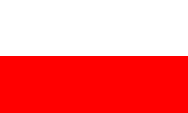
since 1920, from 1991,
Flag of the country and Colours of the country,
Source, by:
AVHz Thüringen, 11.04.1991, § 1 ff.



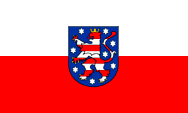
since 1991,
Official flag,
Source, by:
AVHz Thüringen, 11.04.1991, § 1 ff.











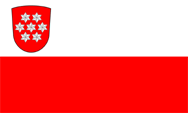
1920–1933,
Presumed official flag,
Source, by: Flags of the World



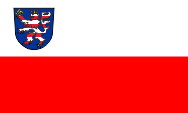
1933–1934,
Presumed official flag,
Source, by: Flags of the World



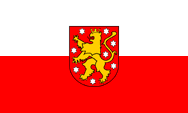
1945–1952,
Presumed official flag,
Source, by: World Statesmen









The Country Thuringia, created in the year 1920 out of seven smaller states, adoped in that year a white-red Bicolor as flag. The colours go back to the lion in the coat of arms of the Landgraviate of Thuringia in the 12th and 13th centuries, from which the country finally emerged, which was horizontally striped in white and red. The representation of the bicolor with the coat of arms is considered as the official flag, that flag, which use is reserved for offices and authorities. Such a regulation is only known to have been handed down with the AVHz of the State of Thuringia from 11th of April in 1991. For the period before, 1920–1933, 1933–1934 and 1949–1952, such a regulation has not been handed down, which does not mean that it never would have existed, depictions who show the coat of arms appear again and again.
Another incident for the flag was the seizure of power by the National Socialists in the German Empire in 1933. All official non-swastika flags, that refered to federalism, regional references or the old German Empire were abolished between 1933 and 1935. For the National Socialists, the federal structure of the German Empire, its historically grown countries, was considered as outdated, as relics of a past to be overcome. In this sense, several laws were enacted, on 31st of March in 1933 the 'Provisional Law for the phasing of the countries with the Empire', on 7th of April 1933 the 'Second Law for the phasing of the countries with the Empire' and finally, on 30th January in 1934 the 'Law on the rebuilding of the empire'. Thus, the federal structure of the German Empire was replaced by the gau-structure of the NSDAP, the countries became meaningless. From now on, offices and authorities had to use the swastika flag as official flag, until September 15th in 1935, when by the flag-law was legislated a new created official flag for all the offices and authorities of the empire. The prime ministers of the countries, which latest in 1933 all came from the NSDAP – now mostly called Reichsstatthalter (maybe translated as 'governor') – however remained in office until 1945. The corresponding country colours continued, with restrictions, but definitly not in the form of flags. They were used, for example, occasionally on uniforms of the SA or in some ranks of the Hitler Youth in the breast cord.
After the war, the administration within the German Empire was rebuilt, but locally, following the structure of the countries. These have been partly old countries, and some new countries were created. Sometimes they bethought the old country colours and reactivated them – or they created new ones – for limited sovereign duties, which were under the control of the Allies. With the founding of the FRG and the GDR, an internal country-structure was finalised for both entities and corresponding official flags were introduced for these countries.
In the year 1945 the Country Thuringia adoped a new coat of arms after the incorporation of Prussian territories: On the red red shield appear a golden lion and now eight six jagged stars. One star was added for the Prussian territories. The white-red flag Thuringia maintained also as a country of the GDR. With the liquidation of the countries in the year 1952 the flag was abolished. The white-red flag of Thuringia was revived in 1990 on the occasion of the re-establishment of the country.
Source:
Jens Hild,
Volker Preuß,
www.sachsenlied.de,
Jürgen Kaltschmitt,
Uniform-Fibel


1131–1247,
Coat of arms of the Landgraviate of Thuringia,
Source, by: Wikipedia (DE)

1920–1933,
Coat of arms of Thuringia,
Source, by: Wikipedia (DE)
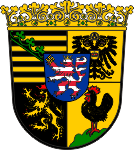
1933–1945,
Coat of arms of Thuringia,
Source, by: Deutsche Ortswappen
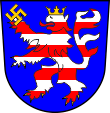
1933–1945,
Lesser Coat of arms of Thuringia,
Source, by: Wikipedia (DE)

1945–1952,
Coat of arms of Thuringia,
Source, by: wertfauna.de

since 1991,
Coat of arms of Thuringia,
Source, by: Wikipedia (DE)

The coat of arms of Thuringia goes back to the Landgraviate of Thuringia of the 12th and 13th centuries. After the extinction of the male line of Landgraves – the House of Ludowinger – in 1247, there was a succession war between the Margraves of Meissen (House Wettin) and the Duchy of Brabant (Sophie, Duchess of Brabant, House of Ludowinger). The war ended in 1264 and much parts in the east of the Landgraviate of Thuringia came to the House of Wettin. Those became later the Wettin-Ernestine duchies. The West came as Landgraviate of Hesse to the son of Sophie of Brabant. The Thuringian coat of arms (white-red striped lion on blue) was adopted by both dynasties.
In 1485 happened the "Leipzig Partition" of the Wettin land between the brothers Duke Albrecht (progenitor of the Albertines) and Elector Ernst (progenitor of the Ernestines). Elector Ernst received the Electorate of Saxony, plus Southern Thuringia and the Vogtland. In the "Wittenberg Capitulation" of 1547, the Ernestines lose the Saxon electorate and become dukes of Saxony, which in the following centuries (in which the Thuringian coat of arms played no role) split into various ducal lines, which remained in power until 1918. At that time the Thuringian lion only represented the inherited title of a 'Landgrave of Thuringia' in the coat of arms of the respective duke, as one out of many. In 1920, seven Thuringian Free States were united to the State of Thuringia. A new creation was adopted as the coat of arms, which therefore showed seven white stars on a red background.
In 1933, a new coat of arms was introduced. It showed a quartered shield with a central heart shield. The squares showed the heraldry of Saxony (Wettin Ernestine line), of Schwarzburg, of Reuss and of Henneberg. The central shield showed the now revived blue shield of the County of Thuringia with a white and red striped lion, however, with a golden swastika in its right paw.
After the war, the state of Thuringia was re-established in 1945, which became part of the German Democratic Republic (GDR) from 1949, but the countries were abolished in 1952 in the GDR. The coat of arms of Thuringia between 1945 and 1952 showed a golden lion without crown on a red, with eight white stars scattered red shield. The eighth star was added to represent the former Prussian areas of Thuringia (for example Erfurt, Suhl, Ranis).
When the federal Country of Thuringia was newly founded in 1990, the old coat of arms of the Landgraviate of Thuringia between 1145 and 1254 was revived by law in 1991, however the white-red striped lion begins with red on the top, possibly to better distinguish this coat of arms from that of the Country of Hesse. The blue shield is additionally sprinkled with eight white stars, which (as between 1945 and 1952) represent the old parts of the country.
Due to the desire to use the coat of arms of Thuringia without permission from anyone, a country-signet was created for this purpose. It can be used by everyone, but its not allowed to change it.
Source: Volker Preuß,
Wikipedia (D),
Deutsche Wappen Rolle

"The usage of the Thuringian coat of arms is reserved for the Landtag (Parliament) and the government of the state as well as other legally authorised offices. The for the use of the coat of arms not entitled can express their attachment to the Free State of Thuringia by use of the Thuringia signet, shown in the right next picture."
Quote by:
thueringen.de
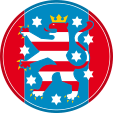
Signet of the Free State of Thuringia,
Source, by:
thueringen.de

FRG and its countries, clickable map:
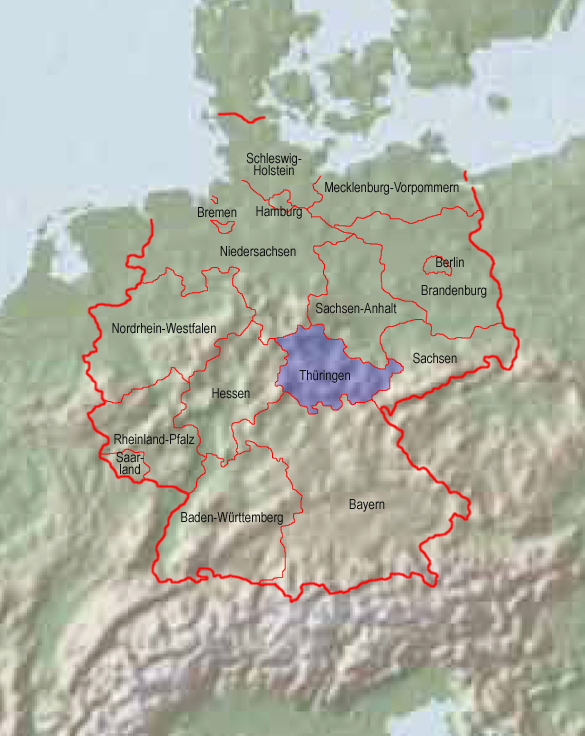
Source: Freeware, University of Texas Libraries, modyfied by: Volker Preuß

Area: 6.244 square miles
Inhabitants: 2.134.500 (2019)
Density of Population: 342 inh./sq.mi.
Capital: Erfurt, 213.700 inh. (2018)
Currency 1920–1924: 1 Mark = 100 Pfennig
Currency 1924–1948: 1 Reichsmark (RM) = 100 Reichspfennig (Rpf.)
Currency 1948–1952: 1 Mark der Deutschen Notenbank (MDN) = 100 Pfennig (Pf.)
Source: Wikipedia (D),
Der Michel

531 · conquest of the Thuringian Empire by the Frankish king Theuderich, since them a Frankish province
8th cent. · christianization by Bonifatius
1130 · the house of the Ludowingers will be levied in the dignity of a landgrave by king Lothar III.
1247 · vanish of the Ludowingers, succession by the House of Wettin (Heinrich the Illustrious)
1264 · abandonment of the Hassian western territory
1485 · "Leipzig partition" of the Wettin's estates between the brethren duke Albrecht (progenitor of the Wettin-Albertinians) and elector Ernst (progenitor of the Wettin-Ernestinians); Duke Albrecht: Land of Meissen, western Osterland, North Thuringia; Elector Ernst: Electorate of Saxony, South Thuringia, Vogtland
1547 · "Wittenberg capitulation" the Ernestinians lose the dignity of election
16th until 19th cent. · by inheritation arise many particular reigns, finally one grand duchy, three duchies and four principalities
1918 · November revolution, the monarchies become unseated and there come into being nine free states
1920 · confederation of eight free states to the Country Thuringia, only the Free State of Coburg joins Bavaria
1921 · new constitution, the Country Thuringia becomes the Free State of Thuringia
1945 · occupation by US-American troops, however Thuringia comes to the Soviet occupation zone, incorporation of Prussian territories
1949 · Thuringia becomes a Country of the GDR
1952 · the countries of the GDR (and therewith Thuringia) get dissolved
1990 · reconstruction of the Free State of Thuringia, the Free State of
Thuringia becomes a federal country of the FRG
Source:
Atlas zur Geschichte,
RetroBib Retrobibliothek,
Discovery '97,
Weltgeschichte,
Wikipedia (D)

The name Thuringia comes from the old Kingdom of Thuringia, which was destroyed and annexed by the Franks in the 6th century. The Duchy of Thuringia was founded in the 7th century, which in turn only lasted for one century. This was not a tribal duchy, however, since the Thuringians no longer existed. In 1131 the later Emperor Lothar III. established the Landgraviate of Thuringia and gave it to the House of the Ludovingians, who died out in 1247. The country was divided in 1264 after a war of succession between the House of Wettin (as the Landgraviate of Thuringia) and the House of Brabant (as the Landgraviate of Hesse). However, the title "Landgrave of Thuringia" was continued by all lines of the Wettin family and inherited again and again, displayed in the coat of arms etc. and did not come to its official end until 1918, when the monarchies in Germany ended. It remained as the name for the country.
Source: Volker Preuß

• Grand Duchy of Saxony-Weimar-Eisenach
• Duchy of Saxony-Gotha-Altenburg
• Duchy of Saxony-Coburg-Saalfeld
• Duchy of Saxony-Meiningen
• Duchy of Saxony-Hildburghausen
• Principality of Schwarzburg-Rudolstadt
• Principality of Schwarzburg-Sondershausen
• Principality Reuss Senior Line (Reuss-Greiz)
• Principality Reuss-Lobenstein (to 1824)
• Principality Reuss-Ebersdorf (bis 1824)
• Principality Reuss-Schleiz

• Grand Duchy of Saxony–Weimar–Eisenach
• Duchy of Saxony–Meiningen
• Duchy of Saxony–Altenburg
• Duchy of Saxony–Coburg–Gotha
• Principality of Schwarzburg–Rudolstadt
• Principality of Schwarzburg–Sondershausen
• Principality of Reuss Senior Line (Reuss-Greiz)
• Principality of Reuss-Schleiz (to 1848)
• Principality of Reuss-Lobenstein-Ebersdorf (to 1848)
• Principality of Reuss Junior Line (Reuss-Gera), from 1848
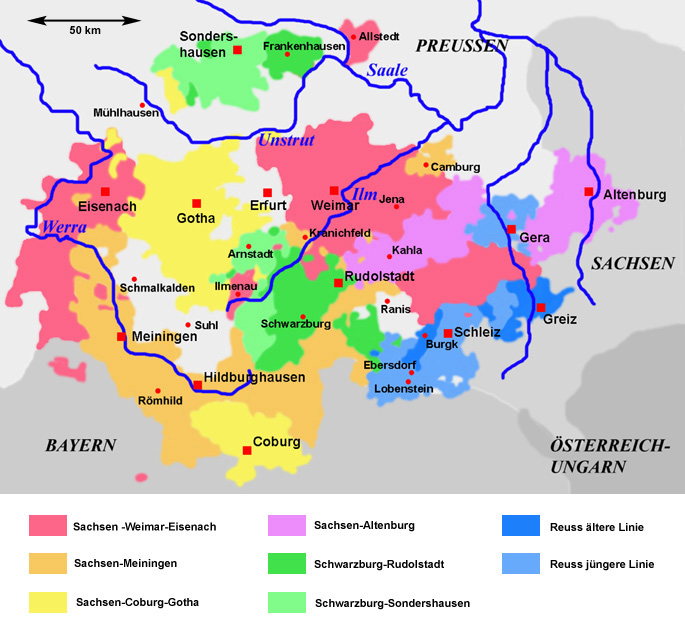
Source: Volker Preuß

• Free People's State of Sax.-Weimar–Eisenach
• Free State of Saxony-Meiningen
• Free State of Saxony-Altenburg
• Free State of Coburg
• Free State of Gotha
• Free State of Schwarzburg-Rudolstadt
• Free State of Schwarzburg-Sondershausen
• bis 1919 People's State of Reuss-Greiz
• bis 1919 People's State of Reuss-Gera
• ab 1919 People's State of Reuss (Greiz+Gera)








![]()

























